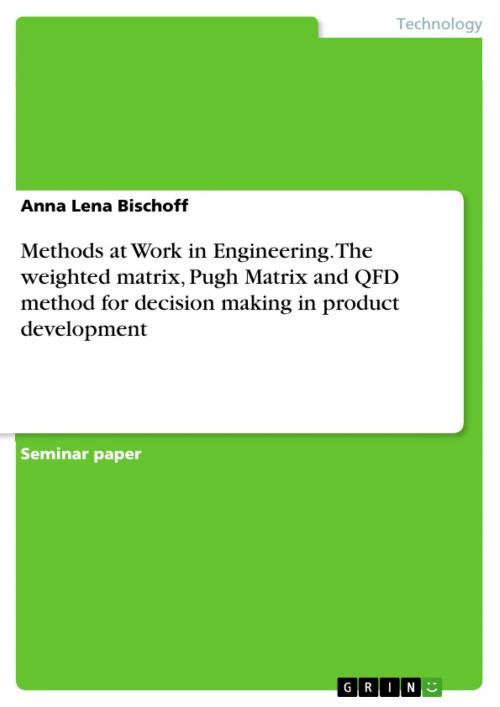Methods at Work in Engineering. The weighted matrix, Pugh Matrix and QFD method for decision making in product development
Nonfiction, Science & Nature, Technology| Author: | Anna Lena Bischoff | ISBN: | 9783668152090 |
| Publisher: | GRIN Publishing | Publication: | February 16, 2016 |
| Imprint: | GRIN Publishing | Language: | English |
| Author: | Anna Lena Bischoff |
| ISBN: | 9783668152090 |
| Publisher: | GRIN Publishing |
| Publication: | February 16, 2016 |
| Imprint: | GRIN Publishing |
| Language: | English |
Seminar paper from the year 2016 in the subject Engineering - General, Basics, grade: 1,3, Linnaeus University (School of Engineering and Business), course: Methods at Work, language: English, abstract: Only suitable methods can help to move forward in the process of product development. Therefore it is important to choose a method that fits the product, current stage of development process and the team. The project is currently in the evaluation phase in accordance to the value methodology. One of the major purposes of this stage is to come up with a short list of projects with the highest potential. Hence, a selection process needs to be executed to produce a focused concept. The focus concept will then be used in the next stages to be developed further. The weighted matrix is a method that is used at an early stage in product development process to select a concept that looks the most promising. This method helps to increase customer value and at the same time make a selection that is objective. Therefore the weighted matrix was chosen in this project to help make a selection among the choice of concepts. Often it is difficult to come to a consensus among group members as everyone is biased by their profession. Everyone has a subjective way of ranking the concepts according to their experiences and knowledge. Such a ranking can lead to dissatisfaction and conflicts in the team as well as choosing a concept that has not the most potential from a customer perspective. The weighted matrix makes the decision process on the one hand a group experience where everyone is involved and gets the acknowledgement of their knowledge and on the other hand more objective.
Seminar paper from the year 2016 in the subject Engineering - General, Basics, grade: 1,3, Linnaeus University (School of Engineering and Business), course: Methods at Work, language: English, abstract: Only suitable methods can help to move forward in the process of product development. Therefore it is important to choose a method that fits the product, current stage of development process and the team. The project is currently in the evaluation phase in accordance to the value methodology. One of the major purposes of this stage is to come up with a short list of projects with the highest potential. Hence, a selection process needs to be executed to produce a focused concept. The focus concept will then be used in the next stages to be developed further. The weighted matrix is a method that is used at an early stage in product development process to select a concept that looks the most promising. This method helps to increase customer value and at the same time make a selection that is objective. Therefore the weighted matrix was chosen in this project to help make a selection among the choice of concepts. Often it is difficult to come to a consensus among group members as everyone is biased by their profession. Everyone has a subjective way of ranking the concepts according to their experiences and knowledge. Such a ranking can lead to dissatisfaction and conflicts in the team as well as choosing a concept that has not the most potential from a customer perspective. The weighted matrix makes the decision process on the one hand a group experience where everyone is involved and gets the acknowledgement of their knowledge and on the other hand more objective.















